Evaluation of general practice house officer attachments in Counties Manukau: insights and benefits
Lyndsay Le Comte 1 , Brooke Hayward 1 , David Hughes 1 , Luis Villa 1 , Dominic Madell 11 Ko Awatea, Counties Manukau Health, New Zealand
Correspondence to: Brooke Hayward, Ko Awatea Research Office, Level 1 Esmé Green Building, Middlemore Hospital, 100 Hospital Road, Otahuhu, Private Bag 93311, Auckland 1640, New Zealand. Email: Brooke.Hayward@middlemore.co.nz
Journal of Primary Health Care 8(4) 288-294 https://doi.org/10.1071/HC16001
Published: 21 December 2016
Journal Compilation © Royal New Zealand College of General Practitioners 2016.
This is an open access article licensed under a Creative Commons Attribution-NonCommercial-NoDerivatives 4.0 International License.
Abstract
BACKGROUND: The Medical Council of New Zealand requires graduating doctors to have community attachments within their first two years of practice by 2020. Counties Manukau Health has developed a programme where house officers (HOs) are attached to a general practice for three months.
AIM: This study aimed to establish the value of four HO general practice attachments in Counties Manukau and describe how HOs are being used in these practices.
METHODS: A mixed-methods design was used to evaluate three attachment runs. Two practices provided the number of patients seen by HOs. Fifty-eight patients were surveyed to assess patient perceptions of the HOs. Six HOs, four supervising general practitioners, two PHO senior staff and one practice manager participated in semi-structured interviews. Focus groups were held with nurses, doctors and administrative staff at all four practices.
FINDINGS: HOs saw 300–600 patients in one practice and 800–1000 in the other during their attachment. Practices developed their own approach to mentoring and teaching HOs. Most patients reported positive perceptions of the HOs. Themes from interviews and focus groups were consistent among participants and included: improved HO confidence, clinical skills and understanding of general practice; extra capacity and improved quality of care and staff satisfaction among practices.
CONCLUSION: HOs and practices viewed HO attachments in general practice positively. HOs developed clinical skills and understanding of primary health care. Practice teams enjoyed the energy and enthusiasm of the HOs, while providing clinical support to ensure quality patient care.
KEYWORDS: Physicians; primary care; hospital; general practice; evaluation research; teaching
| WHAT GAP THIS FILLS |
| What is already known: The Medical Council of New Zealand requires that by 2020 all graduating doctors have community attachments, such as in general practice, within their first two years of practice. Through attachments, HOs gain insight into community and primary health care and increased clinical and consultation skills. It is also a way to promote general practice as a career and enhance communication between primary and secondary care. |
| What this study adds: This evaluation provides information regarding approaches to orientation and teaching of HOs in general practice, and patient perceptions of junior doctors receiving training in general practice in Counties Manukau. It reinforces international evidence for the benefits of HO attachments and adds the perspectives of HOs to existing New Zealand-based research into HO general practice attachments. |
Introduction
In the 2015 Royal New Zealand College of General Practitioners annual workforce survey 56% of respondents were aged ≥ 50 years.1 In response to this aging workforce, changing models of care from siloes to integrated, community-based care and limited hospital specialist positions, the Medical Council of New Zealand is introducing community attachments. Their aim is that by 2020, all graduating doctors have community attachments such as in general practice within their first two years of practice.
General practice attachments are beneficial for new doctors planning careers in either primary care or hospital medicine.2–4 Attachments also promote general practice, can enhance communication between primary and secondary care, and provide house officers (HOs) with a greater understanding of general practitioner (GP) referrals to secondary care and the need for good discharge planning.2–5
Despite international evidence demonstrating benefits of HO attachments in general practice, there is little research into how HOs are used during their placements. In addition, although previous New Zealand research into GPs’ perceptions of general practice attachments for HOs reinforces evidence from international studies, there is a paucity of New Zealand evidence from patients, HOs themselves, and non-GP staff in general practice.5 This study aims to help fill these gaps by evaluating the value of four HO general practice attachments in Counties Manukau and describing how HO placements are being used in these general practices.
Methods
The evaluation used a mixed-methods approach within a ‘realist evaluation’ strategy.6–8 The realist approach identifies ‘what works, for whom and in what circumstances’, assisting decision-makers in identifying what works well and why; where improvements might be made; and how contexts might influence the outcomes sought. The evaluation occurred during three attachment runs commencing February, May and August 2015 with three to four HOs placed in general practice per run. Each attachment lasted for three months and most involved a postgraduate year two HO. The evaluation included interviews with supervising GPs, Primary Health Organisation (PHO) staff, and HOs, focus groups of practice staff, and patient surveys.
Data
The number of patients seen by five HOs during attachments from November 2014 to August 2015 was obtained from two practice management systems. Information relating to patients’ presenting complaints was provided by one practice for two attachments, to show the value and volume of work delivered by HOs. Two practices could not provide this data.
It was intended that receptionists from the four practices would survey 50 consecutive patients who had consulted with a HO. However, only two practices collected this information: one practice collected 50 surveys and the other eight. The surveys aimed to ascertain patient perceptions of junior doctors training in general practice. Questions covered the consultation and investigated whether patient expectations were met, concerns were heard and understood, HOs were confident and respectful, and if patients thought it important for junior doctors to train in general practice. Patients responded on a scale from ‘No, not all’ to ‘Yes, completely’. The number of survey responses collected was too small to imply generaliseability but the surveys’ Likert scales were analysed by frequency of response.
Seven consecutive HOs were invited to participate in interviews following their attachment. One HO declined. The Northern Regional Alliance provided HO contact details. All six HO interviews were audio recorded. An independent third party transcribed the interviews as summaries with selected commentary. Evaluators reviewed audio recordings for in-depth information about areas of interest.
Evaluators interviewed four supervising GPs, one practice manager, and two PHO senior staff to understand how HOs were orientated, supported and used, and any challenges or benefits of the attachments. The Deputy Chief Medical Officer at Counties Manukau Health provided a key contact for each practice and evaluators invited these contacts to participate in the evaluation with any other staff member(s) they deemed appropriate. In one case the key contacts were two PHO staff, in another the practice manager, and at two practices the key contact was the supervising GP.
Four focus groups using a semi-structured interview schedule were held with the wider practice teams, including nurses, doctors and administration staff (as available), to understand their experiences working with HOs. Interviews with key contacts and focus groups with practice staff were documented in detail from notes taken by the evaluators and provided to the key contacts for feedback and sign off.
All qualitative data obtained from interviews and focus groups was thematically analysed with the aid of NVivo 10 software. Analysis was carried out separately by two evaluators who compared their findings. A summative content thematic analysis approach was taken to count and compare keywords, followed by interpretation of the broader context.9
The New Zealand Ethics Committee granted ethical approval for the evaluation (Ref. 2015#33).
FINDINGS
Key contact and supervising GP interviews
In one practice, each HO saw 360–600 patients during the three month attachment. This practice had six GP full time equivalents (FTE) and five nursing FTE for an enrolled population of ~5500 patients. In the second practice, each HO saw 800–1000 patients. This practice had one GP FTE and 1.3 nursing FTE for an enrolled population of ~3100 patients. In all four practices, HOs mainly saw walk-in patients who did not have an appointment.
Supervising GPs reported that it typically took 4–6 weeks to orientate HOs and build their understanding of general practice. In the first few weeks, HOs observed their supervisors, worked with other practice staff, and frequently reviewed and discussed cases. Once the supervisor felt the HO had the necessary skills and confidence they discussed only every fourth patient, or as required. All practices allowed flexibility around consultation length, encouraging HOs to take up to 30 min or longer if needed.
Each practice developed its own approach to mentoring and teaching HOs based on the objectives of the attachment and the broader context of the practice. Figures were developed in consultation with each practice based on the interviews with the key contacts and supervising GPs (Figures 1–4).
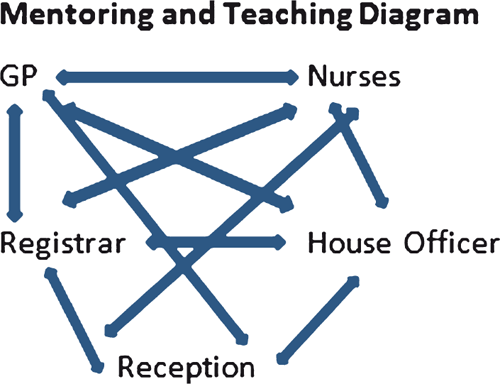
|
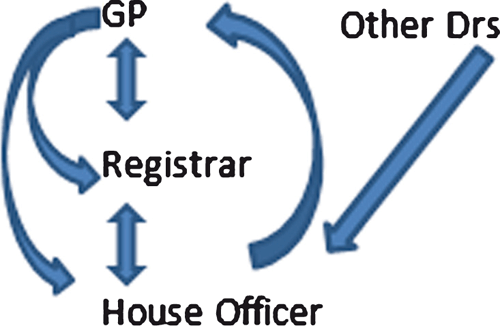
|
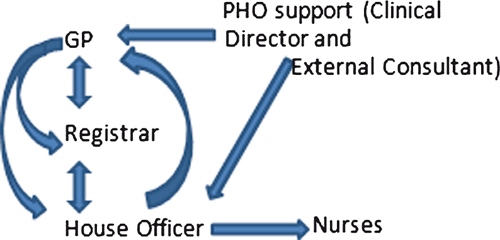
|
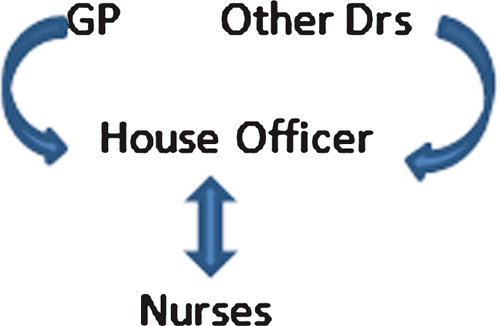
|
Practice A is a small practice with one GP, one registrar, two nurses and an enrolled population of ~1600. The practice used a collaborative approach to training and mentoring HOs that included the nurses and registrar (Figure 1).
Practice B had 6.5 GP FTEs, eight nursing FTEs and an enrolled population of ~11000. Its approach focused on training and support between doctors. This enabled a close working relationship between a small team within a larger practice (Figure 2).
Practice C had one GP FTE, one registrar and an enrolled population of ~3100. This practice was supported by its PHO to provide back-up, education and guidance to HOs, and auditing of patient notes (Figure 3).
Practice D had six GP and five nursing FTEs with an enrolled population of ~5500. This practice included GP and nursing input into training and mentoring HOs. The supervising GP led HO support but other doctors and nurses also provided feedback and support. HOs in turn provided support to nurses (Figure 4).
Patient surveys
Forty-three of 58 patients surveyed agreed that it is important for junior doctors to complete part of their training in general practice. Fifteen were unsure and none disagreed. All patients surveyed either mostly or completely agreed that the HO had treated them with respect, listened, understood their concerns and was confident in caring for them. Most patients surveyed (79%) agreed they would be happy to be seen by a junior doctor who was supported by a senior doctor.
Experiences of house officers and practices
Interviews with HOs were analysed separately from focus groups and interviews with key contacts and supervising GPs. However, due to the overlapping nature of the themes identified through analysis, results from all interviews and focus groups are presented together in Table 1.
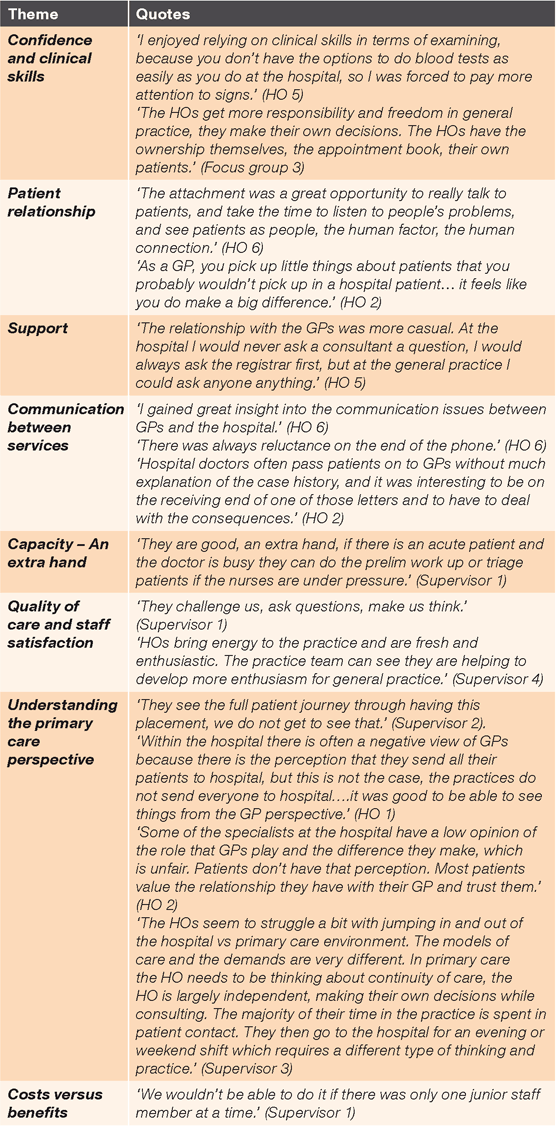
|
Confidence and clinical skills
HOs stated that their placement in general practice increased their confidence with patient examinations and making clinical decisions. However, HOs felt limited in applying their new knowledge when working in the hospital, as the clinical approach and decision-making process in secondary care is different from general practice. One challenge experienced was variation in the level of knowledge and experience of HOs, leading to some practices scaling back the level of responsibility given to them.
Patient relationship
The opportunity to create deep relationships with patients through working in general practice was highlighted by all HOs. However, practice teams had to manage patient expectations: some patients became very attached to HOs and were unwilling see another doctor when the HO finished their attachment.
Support
Feeling supported was key to the HOs having a positive attachment experience. HOs noted that relationships were less hierarchical in general practice than at the hospital. Typically, HOs received additional support from registrars, practice nurses and reception staff. Receiving support from staff other than the supervising GP was important, as at times supervisors were too busy to provide advice.
Communication between services
HOs experienced challenges when communicating with secondary care services, especially the accessibility of clinicians and sometimes a negative attitude towards HOs. HOs noted a lack of feedback or advice from hospital specialists. Practices reported that their relationship or communication with the hospital had not changed, but they temporarily benefited from the HO’s existing contacts within the hospital.
Quality of care and staff satisfaction
HOs and practice staff felt that HOs brought up-to-date or current knowledge to their attachment. Practices also reported that having the HOs helped increase staff morale. HOs generally did not have full caseloads and had flexibility regarding consultation length. Consequently, HOs took on additional tasks such as home visits and were able to spend additional time seeing patients with complex care needs.
However, supervisors raised concerns regarding the quality and safety of patient care due to the impact of HOs working after-hours shifts at Middlemore Hospital following work at the practice. In two separate instances, practices sent their HO home as they felt patient care would have been compromised if the HO had worked that day.
Understanding the primary care perspective
Through attachments, HOs had opportunity to see the full patient journey and to learn about managing patients in the community. However, concerns were raised by practice teams that related to the capacity of HOs to learn about primary health models of care when faced with the challenge of splitting their time between working in practices and then going onto after-hours shifts in the hospital.
Cost versus benefits
Two practices felt the attachments were at best cost neutral, describing the time and effort required to train HOs as equivalent to any income HOs generated through seeing patients. One smaller practice felt there were some financial benefits through maximising the HOs’ ability to see patients from different funding streams while another received funding for HOs from their PHO. Practices felt that there needed to be consistency in the provision of HOs for attachments due to the significant time and financial investment. Training several junior staff simultaneously in terms of induction and teaching hours was identified as one method of making the attachment more financially viable.
Reasons for providing attachments were altruistic. Supervisors wanted to encourage young medical staff into general practice.
Discussion
All involved in the HO attachments viewed the programme positively. This aligns with the literature.2,3,7,10 Brett found that exposure of HOs to primary care complemented experience gained through hospital placements.2 In particular, HOs developed a greater understanding of GP referrals and the importance of discharge planning. Similarly, the Counties Manukau HOs reported that they understood primary care better and were more sympathetic to the challenges faced by GPs, particularly the disconnect between primary and secondary care services and difficulties communicating with hospital staff.
There were several similarities in the attachments. HOs primarily saw walk-in patients and had longer to spend with patients. Supervisors also commonly felt that it took 4–6 weeks to orientate HOs, and 3 months for them to be fully up and running. Funding was also a concern and needs to align with the higher supervisory workload of training HOs, compared to registrars, and their lesser contribution to practice workloads.10–12
Larger fully staffed practices typically found HOs to be useful additional capacity, with no change to the services they provided. In contrast, HOs enabled smaller practices to do more, leading to a sense of improved patient care. Although some comparable studies distinguish between rural and urban practices,3,10,13 no information was found on the size of practice and its impact on practices or HOs’ experiences.
One key issue practices raised was consistency in securing HOs as a way to reduce costs to general practice. The preparation undertaken by GPs to accommodate an HO carries significant financial investment, which becomes a loss when HO attachments are not filled. For example, the cost of an empty consult room, telephone set up, computer and systems set up, and workload redistribution to other practice staff.4,10
Teaching needs to be matched to practice context and patient characteristics, and successful strategies may vary across practices.10 The evaluators developed an orientation framework based on the qualitative data gathered through interview feedback and the existing processes of the four practices (Figure 5). This framework suggests opportunities where HOs could benefit through spending time with other practice staff while allowing flexibility for practices to incorporate the model into their context.
Limitations
As with any qualitative research, misinterpretation and interviewer bias are limitations of this evaluation. However, focus group and interview summaries were confirmed with participants to ensure accuracy.
Although patient surveys were an appropriate method for this evaluation, responses were collected from only two of the four practices, with the majority of responses (50/58) from one practice.
The study is limited in its generalisability by the small number of HOs and practices participating in general practice attachments for HOs and the small geographic area covered. However, the results and themes identified were consistent across interviewees and with the literature.
Conclusion
HO attachments in general practice were viewed positively by HOs and practices. HOs developed their clinical skills and understanding of primary health care. Practice teams enjoyed the energy and enthusiasm of the HOs, while providing clinical support to ensure quality patient care.
COMPETING INTERESTS
None.
ACKNOWLEDGEMENTS/FUNDING
Thanks to the practice staff from Airport Oaks-East Tamaki Healthcare, Mangere Family Doctors, Eastside Family Doctor and Turuki Healthcare for your support and participation in this evaluation. We also thank the house officers who participated in the evaluation sharing your future hopes and experiences of the attachments.
References
[1] The Royal New Zealand College of General Practitioners. 2015 Workforce Survey. December 2015.[2] Brett T. New medical graduates: Can general practice help with training? Aust Fam Physician 2008; 37 363–6.
[3] Martin AA, Laurence CO, Black LE, Mugford BV. General practice placements for pre-registration junior doctors: adding value to intern education and training. Med J Aust 2007; 186 349–69.
[4] Sheehan D, Thwaites J, Byrnes I. General practice rotations for post graduate year 1 and 2 house officers—how feasible? N Z Med J 2007; 120 U2770
[5] Anderson K, Haesler E, Stubbs A, Molinari K. Comparing general practice and hospital rotations. Clin Teach 2015; 12 8–13.
| Comparing general practice and hospital rotations.Crossref | GoogleScholarGoogle Scholar |
[6] Greenhalgh T, Humphrey C, Hughes J, et al. How do you modernize a health service? A realist evaluation of whole-scale transformation in London. Milbank Q 2009; 87 391–416.
| How do you modernize a health service? A realist evaluation of whole-scale transformation in London.Crossref | GoogleScholarGoogle Scholar |
[7] Curry N, Harris M, Gunn M, et al. Integrated care pilot in north-west London: a mixed methods evaluation. Int J Integr Care 2013; 13
| Integrated care pilot in north-west London: a mixed methods evaluation.Crossref | GoogleScholarGoogle Scholar |
[8] Best A, Greenhalgh T, Lewis S, et al. Large-System transformation in health care: A realist review. Milbank Q 2012; 90 421–56.
| Large-System transformation in health care: A realist review.Crossref | GoogleScholarGoogle Scholar |
[9] Hsieh HF Shannon SE. Three approaches to qualitative content analysis. Qual Health Res 2005; 15 1277–88.
| Shannon SE. Three approaches to qualitative content analysis.Crossref | GoogleScholarGoogle Scholar |
[10] Sturman N, Re’go P, Dick ML. Rewards costs and challenges: the general practitioners experience of teaching medical students. Med Ed 2011: 45.
[11] Williams C, Cantillon P, Cochrane M. Pre-registration house officers in general practice: the views of GP trainers. Fam. Prac 2001; 18 619–21.
| Pre-registration house officers in general practice: the views of GP trainers.Crossref | GoogleScholarGoogle Scholar | 1:STN:280:DC%2BD3MnptFKnsA%3D%3D&md5=b26e711da2ce071aab730791083a5e49CAS |
[12] Pullon S, Lum R. Clinical teaching capacity in New Zealand general practice. N Z Med J 2008; 121 U2895
[13] Illing J, Taylor G, Zwanenberg T. A qualitative study of pre-registration house officers in general practice. Med Educ 1999; 33 894–900.
| A qualitative study of pre-registration house officers in general practice.Crossref | GoogleScholarGoogle Scholar | 1:STN:280:DC%2BD3c%2FltV2htg%3D%3D&md5=b8dd52eab9d1dbd4424b2edf913b47fdCAS |



